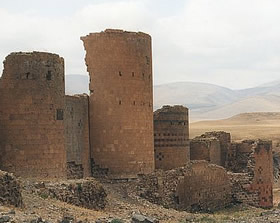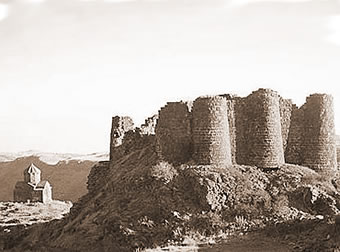Fall of Greater Armenia
Ani, Golden Era of Armenia
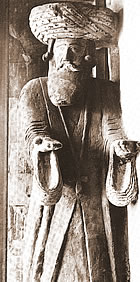 Relief of King Gagik I, from the Cathedral of St.Gregory, in Ani.
Relief of King Gagik I, from the Cathedral of St.Gregory, in Ani.
During the reign of the Kings Abas I (928-951), Ashot III the Merciful (952/953-977), and his sons Smbat II (977-989) and Gagik I (990-1020), Armenia reached the heights of its golden era. All of these kings ruled from the capital city of Ani, renowned as the city of 1000 and one churches, or the city of fourty gates.
Due to its size, power, and wealth Ani became an important cultural and economic center of its time. Many of Ani’s churches, cathedrals, palaces, and fortifications were amongst the most technically and artistically advanced structures in the world.
Tiridates, the Architect
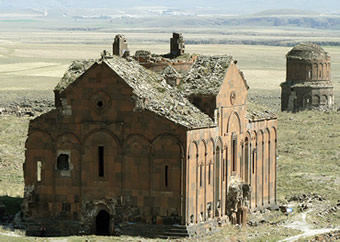 Ruins of the Cathedral and the church of Redeemer, in Ani.
Ruins of the Cathedral and the church of Redeemer, in Ani.
Photo sourse: Flickr, Antonio
Many churches in Ani were built by architect Tiridates. In 990, he built the Cathological palace in Arkina, near Ani, and the splendid Cathedral of Ani. Some european scholars (such as Joseph Strzhykowski, Charle Diehl and others) have noted that many structural features of the Ani Cathedral are innovations which later on have been borrowed and further developed by Roman and Gothic architects.
The fame of Tiridates spread outside of Armenia. In 989 he was invited to Constantinople where he restored the dome of St.Sophia which was destroyed after an earthquake. His restoration stands to this day.
The Turks emerge
However, new disastrous invasions marked the beginning of a new millennium. The Seljuk Turks emerged as a new dangerous power. The Vaspurakan province was the first to be attacked. As mentioned above, this province was ruled by Ardsrouni princes who proclaimed themselves kings. Unable to secure the country against the new enemy, the King Senekerim sought the protection of Emperor Basil II. As a result of their mutual accord, Basil II took the possession of Vaspurakan giving Senekerim one of the Greek provinces in exchange. Meanwhile, the Seljuks tried to capture the old Armenian city of Dvin, but were put to rout by Vahram Pahlavouni, Sparapet of Armenia.
Gagik II
During the next 50 years the Greeks gradually annexed the important part of the Great Armenia. Torn between the Turkish danger and co-religionist Byzantine power, Armenia was at the threshold of a national disaster. The army of Constantine IX besieged Ani in 1041. The Sparapet Vahram Pahlavouni, at the time 80 years old, repeatedly repulsed the enemy. Soon after, the Greeks raised the siege. A 16-year-old Gaguik II arrived in Ani and was proclaimed King of Armenia.
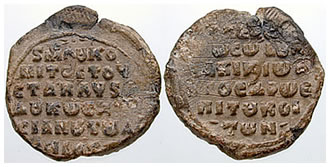 As compensation for his lost Armenian crown,
As compensation for his lost Armenian crown,
Armenia falls under the Turks
The Greek dominance in Armenia ended in 1071, after the famous battle of Manzikert. The 100-thousandth army of Byzantines including the Armenian forces met with the huge army of Seljuks under Alp Aslan. The Christians led by the Emperor Romanus Diogenes were defeated, and Diogenes was imprisoned by Alp Aslan. The Turks took control over all of the Greater Armenia.
Armenians and Georgians unite
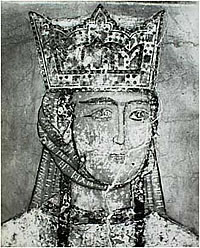 A fragment of the early 13th century fresco of Queen Tamar from Betania, TiflisIn the 12th century and in the beginning of the 13th century, a number of Armenian nobles joined with the neighboring Georgians, in an attempt to liberate the Armenian lands. The strengthening Georgian Kingdom was at the time ruled by a branch of the Armenian Bagradouni dynasty. After a number of uprisings that took place in 1124, 1161 and 1174, the Seljuk rule was overthrown in different cities of Greater Armenia. During the reign of Queen Tamar (1184-1213), some important cities of Greater Armenia, such as Ani, Kars and Dvin were retaken from the Turks. The military expeditions were led by Armenian nobles Zakare Zakarian and his brother Ivane, favorite of Queen Tamar.
A fragment of the early 13th century fresco of Queen Tamar from Betania, TiflisIn the 12th century and in the beginning of the 13th century, a number of Armenian nobles joined with the neighboring Georgians, in an attempt to liberate the Armenian lands. The strengthening Georgian Kingdom was at the time ruled by a branch of the Armenian Bagradouni dynasty. After a number of uprisings that took place in 1124, 1161 and 1174, the Seljuk rule was overthrown in different cities of Greater Armenia. During the reign of Queen Tamar (1184-1213), some important cities of Greater Armenia, such as Ani, Kars and Dvin were retaken from the Turks. The military expeditions were led by Armenian nobles Zakare Zakarian and his brother Ivane, favorite of Queen Tamar.
Mongols and Turkomans in Armenia
The short revival in Armenia ended with the first Mongol invasions in the early 1220’s. During the next 100 years the country was subjected to new campaigns of terror and destruction. The cities and the entire provinces, such as Ani, Kars, Lori, Gandzak, Shamkhor, Khachen, Nakhichevan and many others were destroyed, plundered and set ablaze. After the census taken in 1254, the population was overtaxed. According to Kirakos Gandzaketsi, eyewitness to the events, “…they demanded the most severe taxes, more than a man could bear…They harassed the people with incredible beatings and tortures… Those who hid were seized and killed.”
A number of rebellions led by Armenian and Georgian lords were brutally crushed by Mongols.
From the beginning of the 14th century, the Mongol dominance in the region recedes. Now numerous Turkoman nomadic tribes invade the Armenian lands. Different parts of Armenia become the theater of warfare for the various nomadic clans, such as Kara Koyunlu (Black Sheep) and Ak Koyunlu(White Sheep).


